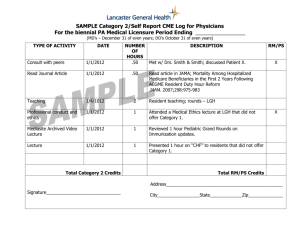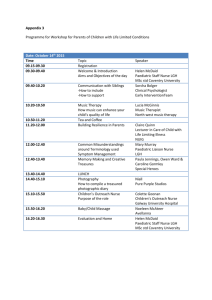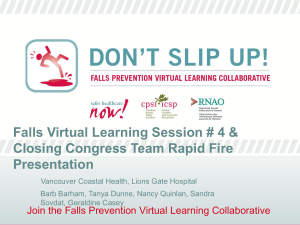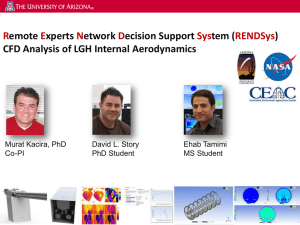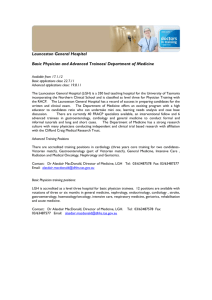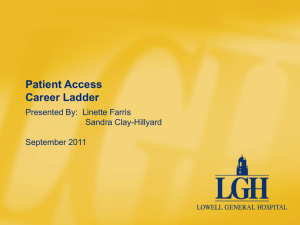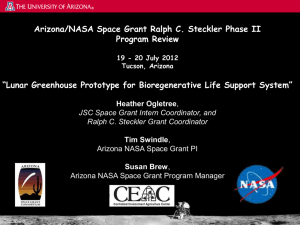The NASA Steckler Space Grant Phase I & Phase II... University of Arizona Controlled Environment Agriculture Center
advertisement
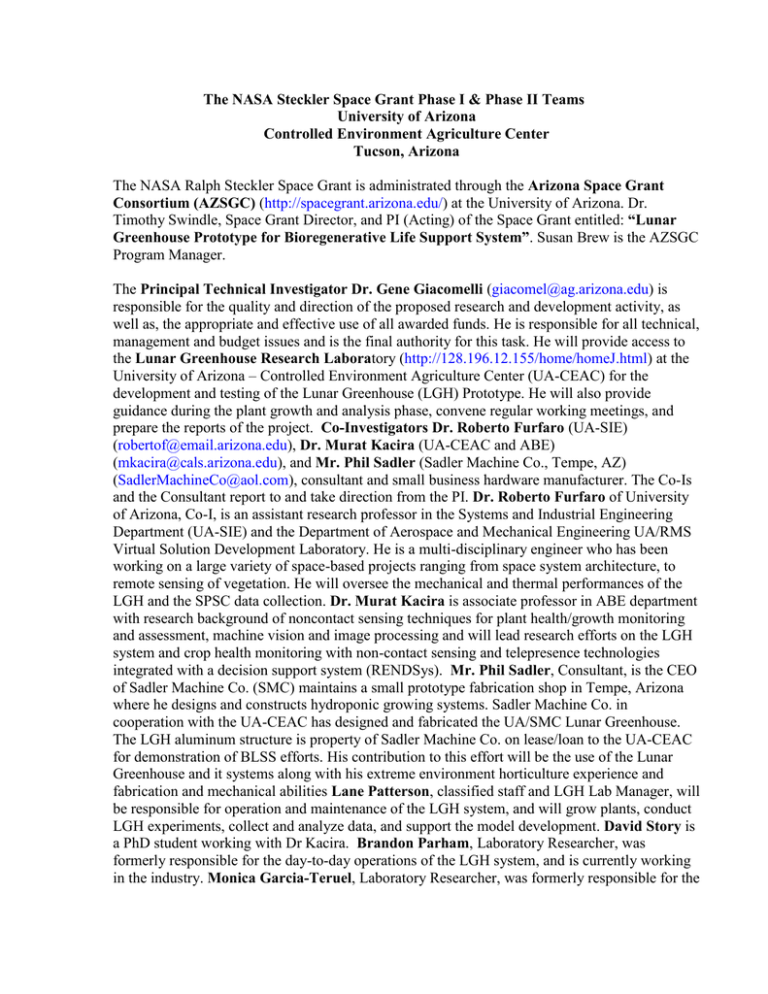
The NASA Steckler Space Grant Phase I & Phase II Teams University of Arizona Controlled Environment Agriculture Center Tucson, Arizona The NASA Ralph Steckler Space Grant is administrated through the Arizona Space Grant Consortium (AZSGC) (http://spacegrant.arizona.edu/) at the University of Arizona. Dr. Timothy Swindle, Space Grant Director, and PI (Acting) of the Space Grant entitled: “Lunar Greenhouse Prototype for Bioregenerative Life Support System”. Susan Brew is the AZSGC Program Manager. The Principal Technical Investigator Dr. Gene Giacomelli (giacomel@ag.arizona.edu) is responsible for the quality and direction of the proposed research and development activity, as well as, the appropriate and effective use of all awarded funds. He is responsible for all technical, management and budget issues and is the final authority for this task. He will provide access to the Lunar Greenhouse Research Laboratory (http://128.196.12.155/home/homeJ.html) at the University of Arizona – Controlled Environment Agriculture Center (UA-CEAC) for the development and testing of the Lunar Greenhouse (LGH) Prototype. He will also provide guidance during the plant growth and analysis phase, convene regular working meetings, and prepare the reports of the project. Co-Investigators Dr. Roberto Furfaro (UA-SIE) (robertof@email.arizona.edu), Dr. Murat Kacira (UA-CEAC and ABE) (mkacira@cals.arizona.edu), and Mr. Phil Sadler (Sadler Machine Co., Tempe, AZ) (SadlerMachineCo@aol.com), consultant and small business hardware manufacturer. The Co-Is and the Consultant report to and take direction from the PI. Dr. Roberto Furfaro of University of Arizona, Co-I, is an assistant research professor in the Systems and Industrial Engineering Department (UA-SIE) and the Department of Aerospace and Mechanical Engineering UA/RMS Virtual Solution Development Laboratory. He is a multi-disciplinary engineer who has been working on a large variety of space-based projects ranging from space system architecture, to remote sensing of vegetation. He will oversee the mechanical and thermal performances of the LGH and the SPSC data collection. Dr. Murat Kacira is associate professor in ABE department with research background of noncontact sensing techniques for plant health/growth monitoring and assessment, machine vision and image processing and will lead research efforts on the LGH system and crop health monitoring with non-contact sensing and telepresence technologies integrated with a decision support system (RENDSys). Mr. Phil Sadler, Consultant, is the CEO of Sadler Machine Co. (SMC) maintains a small prototype fabrication shop in Tempe, Arizona where he designs and constructs hydroponic growing systems. Sadler Machine Co. in cooperation with the UA-CEAC has designed and fabricated the UA/SMC Lunar Greenhouse. The LGH aluminum structure is property of Sadler Machine Co. on lease/loan to the UA-CEAC for demonstration of BLSS efforts. His contribution to this effort will be the use of the Lunar Greenhouse and it systems along with his extreme environment horticulture experience and fabrication and mechanical abilities Lane Patterson, classified staff and LGH Lab Manager, will be responsible for operation and maintenance of the LGH system, and will grow plants, conduct LGH experiments, collect and analyze data, and support the model development. David Story is a PhD student working with Dr Kacira. Brandon Parham, Laboratory Researcher, was formerly responsible for the day-to-day operations of the LGH system, and is currently working in the industry. Monica Garcia-Teruel, Laboratory Researcher, was formerly responsible for the day-to-day operations of the LGH system, and is currently obtaining a degree in Israel. Neal Barto, CEAC engineering support, will provide technical support for the LGH operations, and telepresence system. UA Undergraduate students, Thomas Hillebrand and Michael Downing are preparing for the experiments, installing hardware and monitoring the greenhouse, while Derrick Wibben, Samantha Bernau and graduate student Ehab Tamimi have supported studies of the LGH. International collaboration includes two Italian aerospace companies, and a major university. Cesare Lobascio is the primary contact and Head, Space Environment & Habitats Unit, Space Infrastructures & Transportation, Thales Alenia Space Italia SpA (TASI) in Torino (Cesare.Lobascio@thalesaleniaspace.com), which includes a team of engineers in the Recyclab at TAS-I and a major part of the ASI (Italian Space Agency) supported CAB (Controllo Ambientale Biorigenerativo, Bioregenerative Environmental Control) project. Giorgio Boscheri, is an engineer working for TAS-I (giorgio.boscheri@external.thalesaleniaspace.com), who traveled to UA-CEAC to help in the re-development of the LGH. He and others from the Recyclab continue to provide technical support for the LGH. TASI has hosted Dr Gene Giacomelli for 2 months. Silvio Rossignoli, President Aero-Sekur (ross@sekur.it), SpA and Marzia Pirolli, aerospace engineer (pirolli@sekur.it), Aero-Sekur, SpA, are supporting component designs and hardware materials for the LGH. Aero-Sekur has hosted Dr Gene Giacomelli for 7 months. Dr. Stefania DePascale, University of Naples Federico II, (stefania.depascale@unina.it), as part of CAB project from ASI she offers international scientific research team leadership in crop-environment interaction and has participated in exchange of information and provided the link between the NASA, UA-CEAC Lunar Greenhouse effort and the ASI, CAB effort. Dr. Raymond Wheeler, NASA-KSC was the NASA Technical Advisor to the Phase I part of the project. The following new collaborations and interactions and outreach have been organized for Phase II. Dr. Madhu Thangavelu, Professor in Department of Astronautics at the University of Southern California (USC), who teaches a web-based course, ASTE 527-Space Exploration Architectures Concept Synthesis Studio. During Phase I we presented live from the LGH Lab at UA-CEAC to the Thangavelu class via our web cameras and data collection system. Universities or other schools (K-20) could never have access to such an enriched teaching environment for BLSS, which we can offer remotely and asynchronously. With Dr. Thangavelu, we would like to advance this remote BLSS education capability to multiple institutions (USC, Univ of Roma, Pima Community College) for future aerospace students. Dr. John Hogan, researcher at NASAAmes Research Center (ARC) working in resource recovery for space applications, who will collaborate with the LGH Composter-Wick-Evaporator. Pat Haggerty, The National Science Foundation (NSF) has been key in the development of our extreme environment agriculture capabilities with our construction and operation of the NSF Amundsen-Scott South Pole Station Food Growth Chamber (SPFGC) (Patterson et al., 2008). We have a continuing working relationship with the NSF/Office of Polar Programs (NSF/OPP) as part of our operations support contract. The LGH facility is used for training the operators of the SPFGC before leaving for Antarctica. The LGH and the SPFGC share many common plant production and system features. As the NSF/OPP is tasked with supporting Antarctic science in remote and difficult locations, it is looking to NASA BLSS technology for resolving issues such as waste recycling, crop production, and water conservation. Other outreach to STEM groups include, Dr. Daniel Wright, Pima Community College and Mr. Erik Hanchett, Safford Middle School.
